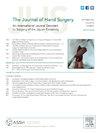影响臂丛神经损伤患者肘关节屈曲功能性腓肠肌游离转移术后疗效的因素:系统回顾与元分析》。
IF 2.1
2区 医学
Q2 ORTHOPEDICS
引用次数: 0
摘要
目的:游离功能性腕弓转移术(FFGT)是臂丛神经损伤后重建肘关节屈曲的一种有效方法,这种损伤出现较晚或之前的神经手术效果不佳。在本系统综述和荟萃分析中,我们旨在研究与卓越疗效相关的变量。我们评估了单路 FFGT 与双路 FFGT 的疗效(其中第一路 FFGT 是为恢复肘关节屈曲而进行的),以及神经化供体神经的选择:方法: 我们进行了一项荟萃分析,其中包括提供术后肘关节屈曲度、手臂、肩部和手部残疾等级、视觉模拟量表评分、肘关节屈曲定量力量和活动范围的医学研究委员会(MRC)研究。研究人员进行了随机效应元回归分析,以确定与疗效改善相关的因素:共分析了 37 项研究,1,607 名患者。34项研究(n = 1,398)报道了单次FFGT,10项研究(n = 209)报道了双次FFGT。平均随访时间为 37.3 ± 21.1 个月。单次 FFGT 后,分别有 75.4% 和 48.9% 的患者达到 MRC 分级≥3 级和≥4 级。双 FFGT 后,100% 达到 MRC 分级≥3,62.7% ≥4。双 FFGT 达到 M3 和 M4 的可能性明显更大。总体而言,由脊神经附属神经支配的 FFGT 在 MRC 等级≥3 级的恢复情况明显更好。如果仅比较脊髓附属神经支配的单FFGT和双FFGT,则肘关节屈曲的恢复没有明显差异。元回归分析显示,患者的年龄与MRC分级≥3级和4级的概率呈显著负相关:结论:在包括所有支配神经的总体分析中,双FFGT优于单FFGT。对脊柱附属神经支配的单层和双层 FFGT 进行分组分析,结果显示两者无明显差异。年龄的增长是导致疗效不佳的重要风险因素:治疗 IV。本文章由计算机程序翻译,如有差异,请以英文原文为准。
Factors Affecting Outcomes After Free Functional Gracilis Muscle Transfer for Elbow Flexion in Brachial Plexus Injury: A Systematic Review and Meta-Analysis
Purpose
Free functional gracilis transfer (FFGT) is a useful option for reconstruction of elbow flexion following brachial plexus injury presenting late or with poor outcomes from previous nerve surgery. In this systematic review and meta-analysis, we aimed to investigate variables associated with superior outcomes. The efficacy of single versus double FFGT, where the first FFGT is performed to restore elbow flexion, and the choice of donor nerve for neurotization were evaluated.
Methods
A meta-analysis was conducted, including studies that provided postoperative Medical Research Council (MRC) grade for elbow flexion, Disabilities of the Arm, Shoulder, and Hand and visual analog scale scores, quantitative elbow flexion strength, and range of motion. A random effects meta-regression analysis was performed to identify factors associated with improved outcomes.
Results
Thirty-seven studies, with 1,607 patients, were analyzed. Single FFGT was reported in 34 studies (n = 1,398), and double FFGT was reported in 10 studies (n = 209). The mean follow-up duration was 37.3 ± 21.1 months. Following single FFGT, 75.4% and 48.9% achieved MRC grades ≥3 and ≥4, respectively. Following double FFGT, 100% achieved an MRC grade ≥3 and 62.7% ≥4. The likelihood of achieving M3 and M4 was significantly greater for double FFGT. Overall, FFGT innervated by the spinal accessory nerve had significantly better recovery of MRC grade ≥3. When comparing only single and double FFGT innervated by spinal accessory nerve, there was no significant difference in recovery of elbow flexion. The meta-regression analysis showed a significant negative correlation between the patient’s age and the probability of achieving an MRC grade of ≥3 and 4.
Conclusions
In the overall analysis encompassing all innervating nerves, double FFGT was superior to single FFGT. Subgroup analysis of single and double FFGT innervated by the spinal accessory nerve showed no significant difference. Increasing age was a significant risk factor for poorer outcomes.
Type of study/level of evidence
Therapeutic IV.
求助全文
通过发布文献求助,成功后即可免费获取论文全文。
去求助
来源期刊
CiteScore
3.20
自引率
10.50%
发文量
402
审稿时长
12 weeks
期刊介绍:
The Journal of Hand Surgery publishes original, peer-reviewed articles related to the pathophysiology, diagnosis, and treatment of diseases and conditions of the upper extremity; these include both clinical and basic science studies, along with case reports. Special features include Review Articles (including Current Concepts and The Hand Surgery Landscape), Reviews of Books and Media, and Letters to the Editor.

 求助内容:
求助内容: 应助结果提醒方式:
应助结果提醒方式:


